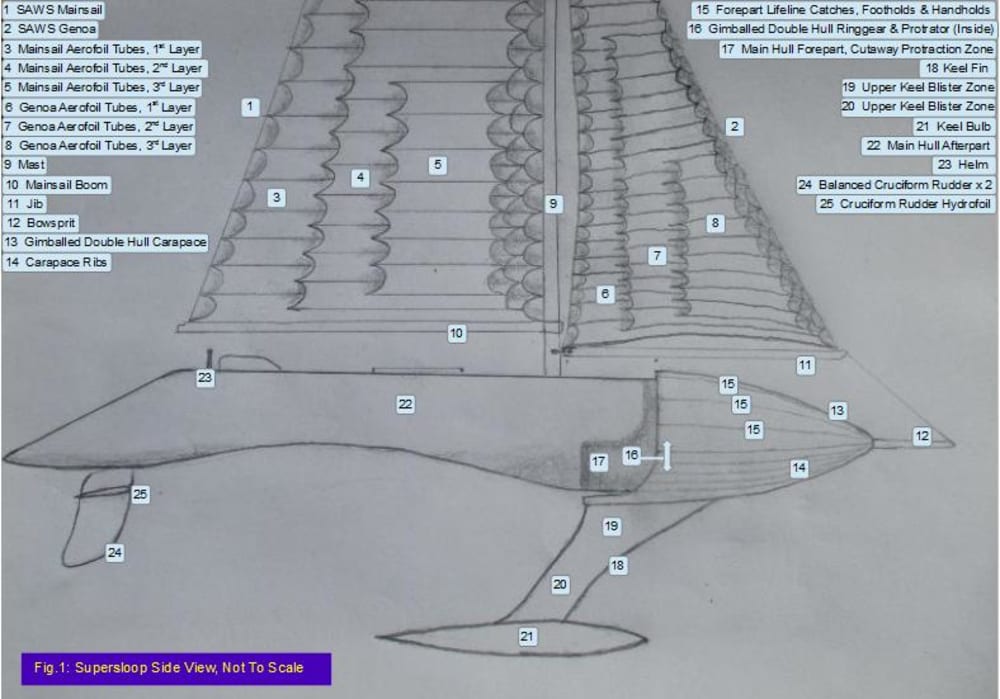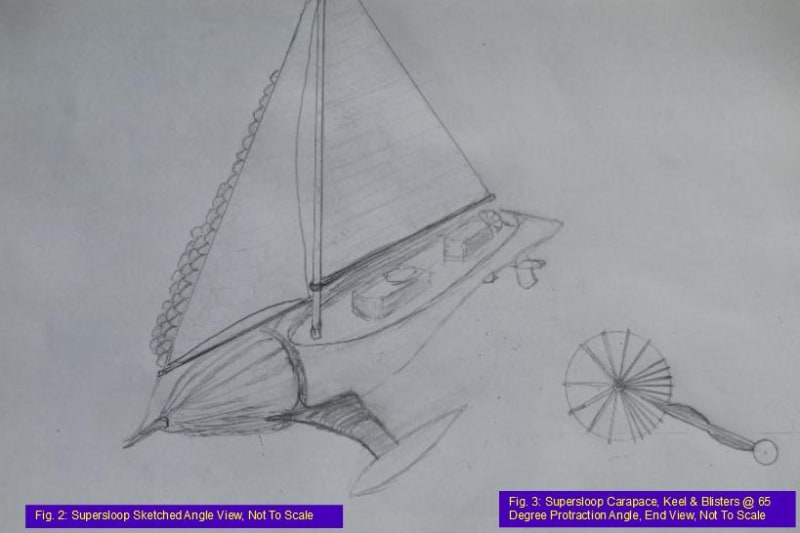The Supersloop design was developed over five years from 1983 to 1988.
It began with keel design during controversy surrounding Australia II's winged keel. I started with the probable first-ever Bulb&Fin keel design, then further modified it with a radical roll moment system on the fin, comprising four variable profile “Blisters” inside stretching rubber skin. The lower pair near the bulb generate strongest roll moment. The upper pair counteract yaw moment. Each has scissor-jack type mechanisms designed to make the fin bulge. When reaching, only lower leeward and upper windward blisters are bulged by scissor-type mechanisms, increasing surface curvature. Higher speed generates more righting force, preventing listing. It keeps the mast vertical in very strong crosswinds, harnessing far more thrust than any conventional yacht, whose sails lose efficiency according to the list angle's cosine: 30% lost at 45o.
“Stacked Array Windbag Sails” further increase thrust, applying the aerodynamic tube design of stunt parachutes to form multiple aerofoil layers on each sail. Genoa and gennacker stacked arrays are on one side only, necessitating two of each type in the inventory. These must be exchanged when changing tack. Spinnacker's one-sided, but only one is required, configured to raise itself higher atop and spread the edges wider. Mainsail cannot be changed underway, so it's double-sided. Windward tubes collapse against the mainsheet, while leeward tubes inflate, forming aerofoils. There's also a stunt parachute-like “Kite”, controllable by twin lines. Total thrust may be increased 1.5 to 2.5 times by these sails.
A 1988 enhancement was the “Protracting Gimballed Double-Hull” design, allowing the keel to generate additional roll moment via protraction outboard to windward, by rotating the forepart carapace bearing the keel. At full speed with keel maximally deployed outboard, the keel's upper part raises out of the water, leaving only the lower blister on its underside submerged and active, increasing efficiency. Main hull section with mast, sails and rudder can still maintain the vertical. This concept predated the “Swinging Keel” by a decade and is still superior in design, function, performance and resilience. Swinging keels are notorious for failing, frequently forcing retirements from races.
The forepart is a stepped conical hydroplaning structure, designed to aquaplane and reduce displacement drag. Its ribs trap an air layer. Twin cruciform hydrofoil rudders under the stern, always kept vertical, raise the aft section entirely clear of the water. Perpetual vertical attitude guarantees steering efficiency is always maximal.
No conventional sloop can aquaplane when reaching. This design can, owing to blistered keel and gimballed double-hull, even with full SAWS outfit. Speeds 40 knots or more are possible when reaching.
All immersible surfaces have sharkskin or comparable flow conditioners to minimise CD.
Vastly increased forces perhaps 12 times greater than normal being harnessed by these features require correspondingly stronger hull, keel and mast construction. Bulb mass can be considerably reduced, however, no longer being considered the dominant roll moment device.
Estimated prototype cost: ≈$30,000,000;
Potential earnings: corporate sponsorship, prizemoney, royalties;
Design applications: yacht racing, shipping;
Benefits: fuel efficiency, speed.
Like this entry?
-
About the Entrant
- Name:Ciarrai Macgiolla Comghail
- Type of entry:individual
- Patent status:none





